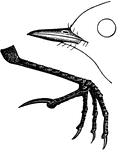Clipart tagged: ‘bird claws’

The Foot of a Bridled Foot
"Sterna anaisthetikos. Bridled Tern. The foot of a Bridled Tern; Tarsus .85; middle toe the same, with…

White-fronted Dove Details
"Details of Engyptila albifrons (White-fronted Dove); head and foot natural size; wing and tail reduced.

The Raptorial Foot of a Hawk
"Fig. 46. - Raptorial foot of a hawk, Accipiter cooperi. The raptorial is another modification of the…
The Foot of a Prairie Hen
"Cupidonia. Tarsi scant-feathered to the toes in front and on sides, bare on a strip behind; toes extensively…

The foot of a Kingfisher
"Fig. 44- Syndactyle foot of a kingfisher. Thus a kingfisher shows what is called a syndactyle or syngnesious…

The Raptorial Foot of an Owl
"Fig. 47. - Raptorial foot of an owl, The raptorial is another modification of the insessorial foot.…

Sooty Tern Foot
"Sterna fuliginosa. Sooty Tern. feet stout; toes short; with much incised webs; tibia bare .70; tarsus…

American Titlark Claw
"Anthus Ludovicianus. Louisiana Pipit. American Titlark. Brown Lark. Wagtail. Bill blackish, pale at…

Zygodactyle Foot of a Woodpecker
"Fig. 45.- Zygodactyle foot of a woodpecker, Hylotomus pileatus. The zygodactyle or yoke-toed modification…